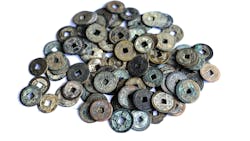Why Protective Coatings Damage Metal Artifacts — and How to Fix It
The chemical industry has played a crucial role in artifact preservation for the best part of a century.
It really started in the 1920s with the advent of ketone resins made from reactions involving methylcyclohexanone and/or cyclohexanone. Within a decade BASF and Howards of Ilford, which ceased operations in 1975, were producing several hundred tons a year of the chemicals, mostly destined for the textiles and coatings industries.
These coatings had several benefits for conservators including ease of application and attractive optical properties, according to an article in the American Institute for Conservation’s Western Association for Art Conservation.
In fact, by the 1950s, ketone resins were being recommended as a replacement for the natural dammar resin that had been used as a picture varnish since 1826.
Unfortunately, it soon became clear that the early ketone resins had a problem: They degraded over time, leading to yellowing.
The article goes on to describe different formulations of the ketone resins created by BASF, Howards and other companies over the next 50 years to solve the yellowing problem and formulate better products for the art conservation market, many of which are still in use.
Metal Caveat
However, new findings described by the researchers as “significant and alarming” have cast doubt on the efficacy of polymer coatings, including acrylic resins, when used to preserve metal artifacts.
Such coatings protect from long-term exposure to light, heat, oxygen and humidity. They are in many ways ideal for this application, being lightweight, transparent and watertight. Plus, they can adhere strongly to the materials they are preserving, including waterlogged wood.
However, researchers at the University of Chemical Technology in Beijing, China, found that aging resin coatings can damage iron-containing metal artifacts by promoting rust formation on them rather than protecting them from it.
The challenge for the researchers was to find out exactly what was happening at the contact point between coating and artifact.
Describing the work in an ACS Central Science article, they explain that current options available for analyzing chemical actions in this thin space rely on peeling away or dissolving the polymer, which could damage the artifact, or imaging techniques that are non-destructive and fast but not of high enough resolution to dig down into the chemistry involved.
So, they developed an in-house 3D fluorescence imaging technique. This showed that polymer aging occurred simultaneously at the surface of the polymer and at its interface with metal artifacts, generating carboxyl groups and hydroxyl radicals. These induce the corrosion and oxidation of metallic artifacts. The new technique works by identifying the presence of carboxyl groups.
They also found that metallic ions generated during this process could further aggravate the aging of polymer coatings.
Old-World Application
In a proof-of-concept demonstration, the researchers tested their new technique on a rusty iron coin from the Northern Song Dynasty (960–1127).
They coated the artifact with acrylic resin B72, an ethyl methacrylate (70%) and methyl acrylate (30%) copolymer, which is the most widely used polymer with metal artifacts and expedited the polymer’s aging process with heat and light.
The aged polymer coating magnified the production of damaging carboxyl groups, making the already-rusty artifact rustier (Figure 1). However, on a new piece of iron, the aged polymer coating did not speed up surface rusting.
“It is surprising to acknowledge that the aged polymers can generate hazardous carboxyl groups and reactive hydroxyl radicals, inducing the oxidation and corrosion of the metal artifacts,” the researchers note in the article.
They go on to put forward some suggestions to improve the situation:
- The storage environment of artifacts should be strictly controlled, in both the presence or absence of polymer coatings.
- Improved research into the structural design and preparation of protective polymers should be carried out prevent them developing defects such as pores.
- The use of specific stabilizers or anti-aging additives in polymer coatings is crucial.
“These actions would promote the protective ability of polymer coatings and reduce the secondary damage to cultural artifacts,” the researchers concluded. “We will keep up the corresponding research on the preservation of cultural artifacts, and it is anticipated that the proposed strategy and findings could provide sufficient information for artifact conservation.”
About the Author
Seán Ottewell
Editor-at-Large
Seán Crevan Ottewell is Chemical Processing's Editor-at-Large. Seán earned his bachelor's of science degree in biochemistry at the University of Warwick and his master's in radiation biochemistry at the University of London. He served as Science Officer with the UK Department of Environment’s Chernobyl Monitoring Unit’s Food Science Radiation Unit, London. His editorial background includes assistant editor, news editor and then editor of The Chemical Engineer, the Institution of Chemical Engineers’ twice monthly technical journal. Prior to joining Chemical Processing in 2012 he was editor of European Chemical Engineer, European Process Engineer, International Power Engineer, and European Laboratory Scientist, with Setform Limited, London.
He is based in East Mayo, Republic of Ireland, where he and his wife Suzi (a maths, biology and chemistry teacher) host guests from all over the world at their holiday cottage in East Mayo.


